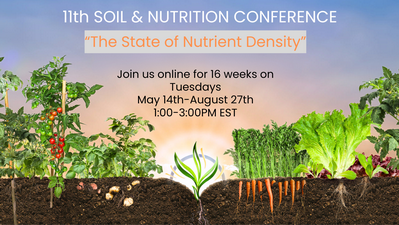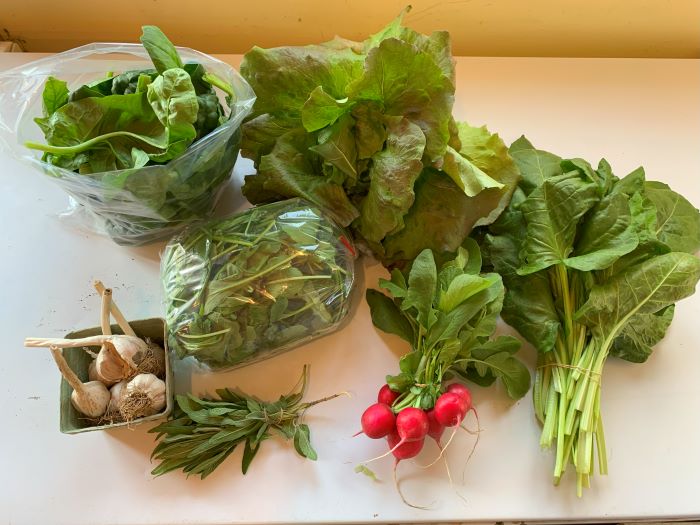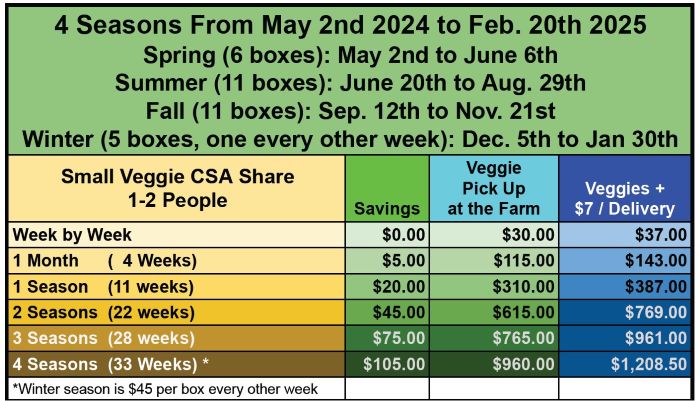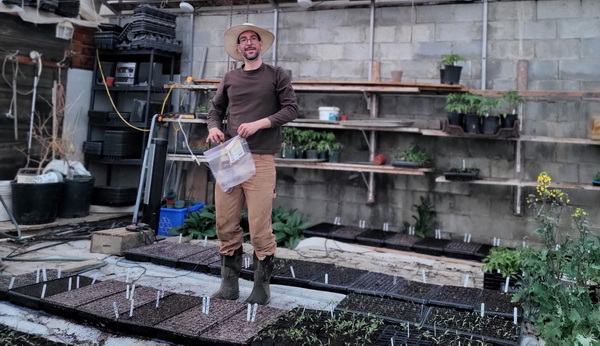The Weblog

This page contains news, event information, and other items added by Ian and Adam, the resident farmers at Old 99. We send out a message every week, but most are set with a delete date about two weeks later. I archive some of the posts if they have content other than weekly availability of produce and meat.
You can send me questions too, which if they are of a general nature, I can post to this Old99 blog.
Week of May 27th, 5th Spring CSA
Hi,
I hope that you are enjoying the spring rain.
This week we have (Asterisk for what will be in this week’s CSA box):
Asparagus
Arugula Roquette*
Chard Yellow and Red*
Fennel*
Green Garlic*
Kale*
Mesculun Salad Mix*
Rhubarb*
Sage
For A la carte orders surf to the online store here to place your custom order. Store pick up Thurs 4 to 6 or by appointment.
For further questions or to sign up kindly reach out by email to email : adam@equilibriumacres.ca
Healthy eating,
Ian, Cami, and Adam
Week of May 20th, 4th Spring CSA
Hello,
I hope that everything is good on your end.
We’ve been busy planting in the front garden and keeping things growing in the greenhouses as well as making ongoing preparation in the fields.
This week we have (Asterisk for what will be in this week’s CSA box):
Asparagus*
Arugula Roquette*
Chard*
Green Garlic*
Mesculun Salad Mix*
Radish*
Rhubarb*
Rouge D’hiver Lettuce
Spinach
Sage
For A la carte orders surf to the online store here to place your custom order. Store pick up Thurs 4 to 6 or by appointment.
For further questions or to sign up kindly reach out by email to email : adam@equilibriumacres.ca
Healthy eating,
Ian, Cami, and Adam
Week of May 13th 3rd Spring CSA
Hi there,
I hope that you’re week is off to a good start.
The Spring Season CSA is underway.
Here is a picture of the contents of last weeks’ box including the last of our stored garlic, Rouge d’Hiver lettuce, green chard, arugula, sage, and vibrant radish.

The farm Store is open on Thursdays from 4 to 6 Pm for Veggie Subscription and a la Carte pickups as well as flexible options by appointment, we’re getting more goodies to share, this week Asparagus is coming up as well as Rhubarb.

Sign ups for the CSA Veggie subscription are open, secure fresh organic veggies for you and your loved ones.
This week we have (Asterisk for what will be in this week’s CSA box):
Asparagus*
Arugula*
Baby Chard*
Baby Kale*
Bok Choi*
Green Garlic
Rainbow Chard
Rhubarb*
Radish
Rouge D’hiver Lettuce
Spinach
Salad Mix*
Sage
For A la carte orders surf to the online store here to place your custom order by Wednesday 11 Am. Store pick up Thurs 4 to 6 or by appointment.
For further questions or to sign up kindly reach out by email to email : adam@equilibriumacres.ca
Healthy eating,
Ian, Cami, and Adam
Upcoming Bionutrient food conference online
How much nutrition is really in our food? That is the raison d’etre of the Bionutrient Food Assoc and its conference-
Did you know that the nutrition facts panel on the side food package does not come from testing the food in it?
Are you aware of the process by which those numbers show up on the side of a package?
What is the path forward to getting those numbers to represent reality? Especially if you are producing or distributing food that is nutritionally superior?
Not that a nutritional facts panel is the be all and end all of where we want to be going, but it is where reality sits now for those who do buy food in a store.
Meet Tina Owens. With a career’s experience in the food industry, she is one of our foremost translators of how the system works so that those of us who want to engage know the rules of the road.

Week of May 6th 2nd Spring CSA
Hello,
I hope that you are doing well.
The Spring Season CSA is off to a good start after last week’s launch.
Here is a picture of the contents of last weeks’ box including the last of our stored garlic, Rouge d’Hiver lettuce, green chard, arugula, sage, and vibrant radish.

The farm Store is open on Thursdays from 4 to 6 Pm for Veggie Subscription and a la Carte pickups as well as flexible options by appointment.
Deliveries are Friday evenings.
Sign ups for the CSA Veggie subscription are open, secure fresh organic veggies for you and your loved ones.
This week we have (Asterisk for what will be in this week’s CSA box):
Arugula*
Bok Choi*
Rhubarb
Green Chard*
Green Garlic*
Radish*
Rouge D’hiver Lettuce
Spinach*
Tokyo Bekana*
Sage
For A la carte orders surf to the online store here to place your custom order. Store pick up Thurs 4 to 6 or by appointment.
For further questions or to sign up kindly reach out by email to email : adam@equilibriumacres.ca
Healthy eating,
Ian, Cami, and Adam
Week of April 29th Launch of 2024 Season
Hello,
I hope that your week is off top a good start.
I am exited to announce that this is the first week of the Equilibrium Acres CSA at Old 99 Farm.
Pickups at the Farm will be from Thursday 4 to 6 Pm and can be held in our fridge until the weekend by request for flexibility of pickup.
Deliveries will be Friday evenings.
There’s still time to sign up for the full year of fresh organic veggies. You get the benefit of being a part of a local farm, and a %10 discount off the price of veggies.
There’s also still 3 dozen eggs for free to the next 3 signups.
For further questions or to sign up kindly reach out by email to email : adam@equilibriumacres.ca
We will open the store this week for a la carte orders.
This week we have (Asterix for what will be in this week’s CSA box):
Spinach*
Arugula*
Green Chard*
Sage*
Rhubarb
Garlic*
Radish*
Rouge D’hiver Lettuce*
For A la carte orders surf to the online store here to place your custom order. Store pick up Thurs 4 to 6 or by arrangement.
Healthy eating,
Ian, Cami, and Adam
Week of April 22nd
Hi there,
I hope that you are doing well.
Season preparations continue with the irrigation system being set up.
We are now 9 days away from Equilibrium Acres Community Shared Agriculture (CSA), Starting May 2nd 2024, we already have signups and room for more, reach out to get fresh local veggies weekly to nourish yourselves with.
Next 5 families to sign get free dozen eggs.
Cost is $30 per week for a small sized basket, enough for 2-3 people, typically about 7 veggies. Spring Season is 6 weeks, from May 2nd to June 6th. For further questions or to sign up kindly reach out by email to email : adam@equilibriumacres.ca
Here’s a breakdown of this years seasons with pricing and savings for paying in advance.

We will open the store this week for a la carte orders, we have:
Spinach
Arugula
Green Chard
Sage
Rhubarb
Garlic
Surf to the online store here to place your custom order. Store pick up Thurs 4 to 6 or by arrangement.
Healthy eating,
Ian, Cami, and Adam
Week of April 15th 2024 Equilibrium Acres CSA
Hi there,
I hope that your week is off to a great start and that you are enjoying the fantastic weather that we are having.
I am keeping busy prepping for the season ahead. The Hobbit House is almost full of seedlings and the first flats are being transplanted in the garden beds.
I am launching the Equilibrium Acres Community Shared Agriculture (CSA) for May 2024.
First 10 families to sign get free dozen eggs.
Cost is $30 per week for, for a small sized basket, enough for 2-3 people, typically about 7 veggies. Spring Season is 6 weeks, from May 2nd to June 6th. For further questions or to sign up kindly reach out by email to email : adam@equilibriumacres.ca
.jpg)
Surf to the online store here to place your custom order. Store pick up Thurs 4 to 6 or by arrangement.
Healthy eating,
Adam
Hey! Hello! Do you want off the list? (Old 99)
We pretty faithfully send out a blog every week to you’all who have signed up for this list, some going back years.
I got one reply this week.
So, pls simply reply, “Take me off the list” or “Keep me”
That way we’ll know who is interested in the healthy whole organic foods we grow for people.
Yours truly,
Ian G
Old 99 Farm, week of Apr 7 2024
Adam’s taking a week off from the veg market so I’m pinch-hitting.
We have first of the season rhubarb, started under plastic in the dark. Its leaves are bright yellow and the stems are dayglo pink/red. Really gorgeous.
In addition the laying hens are really enjoying outside runways and laying tons of eggs. We’ll put them on special for a week, three doz for price of two. If you are new egg customer you get even better offer: three for one!!! (not bought Old 99 eggs in the last year)
What veggies are growing here you ask?
We have kale, chard, mixed greens, arugula, claytonia, lettuce, mache, and spinach. From storage we have garlic and frozen minced garlic paste. Also dried hot peppers.

Adam is pressing on with seeding flats of crops for later transplanting. Here’s a photo showing his handiwork.

Adam’s Community Shared Agriculture (CSA) spring season will start first week of May. First 10 families to sign get free dozen eggs. Cost is $30 per week for 10 weeks, for mid sized basket, enough for 4 people, typically about 7 veggies. Sign up in LocallyGrown.net.
Please place orders by thurs am so we can pick for you ready thurs 4pm, or if you prefer, pick up on the weekend.
The subscription plan “Let Me Be Your Farmer” is up and running. You pay into your account in advance and get first pick of the crop, no delay at checkout and no interac. Typically pay $300 to start, or what you expect to spend in 2 months. Covers all our produce, meats, eggs, etc.
For all inquiries kindly reach out to us with an email : adam@equilibriumacres.ca
Surf to the online store here to place your custom order. Store pick up Thurs 4 to 6 or by arrangement.
Healthy eating,
Ian, Adam and Cami